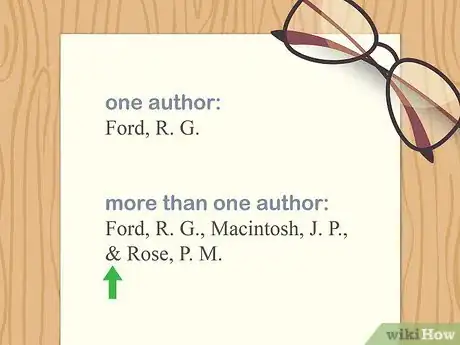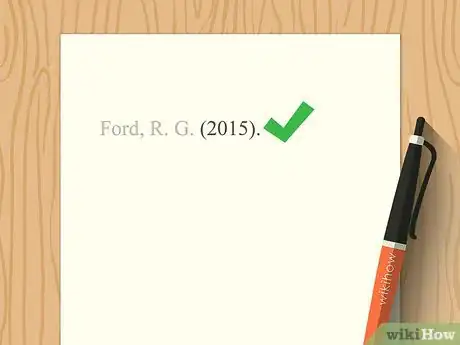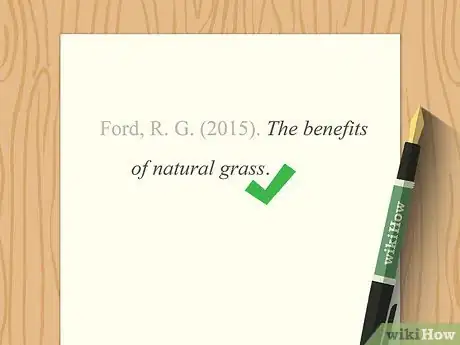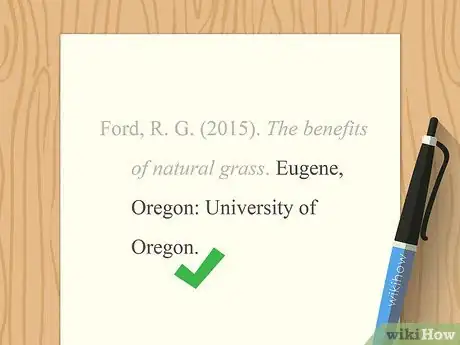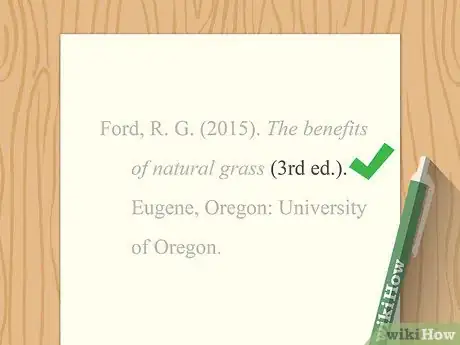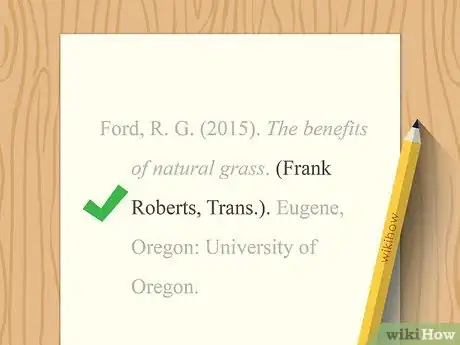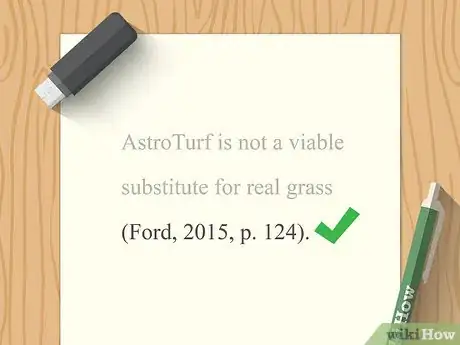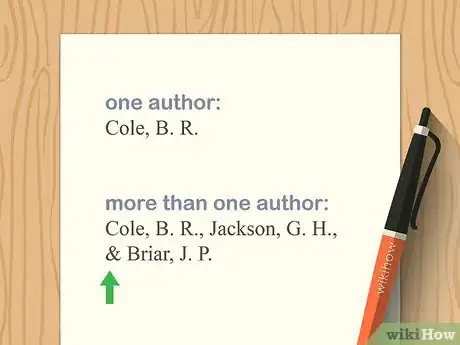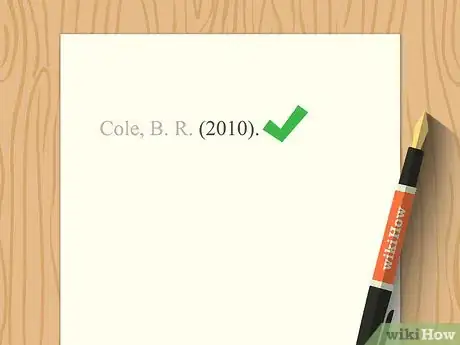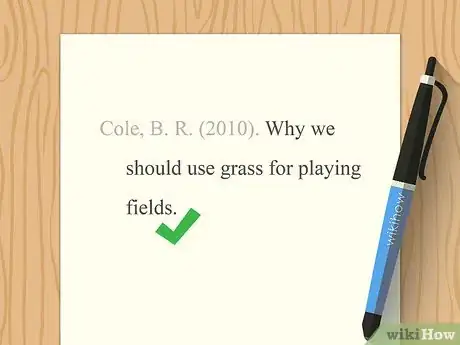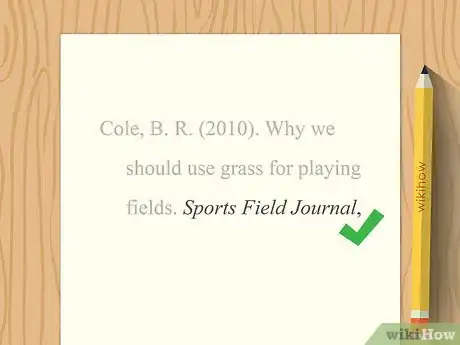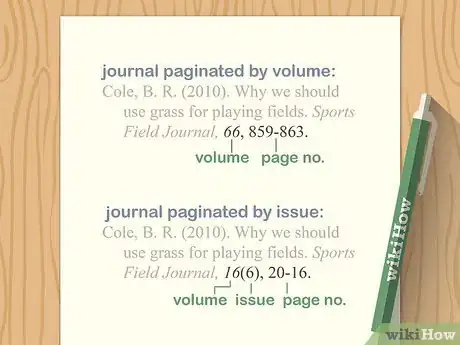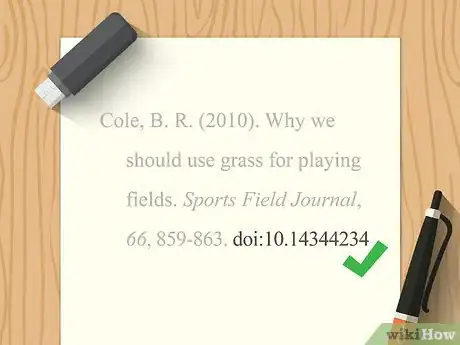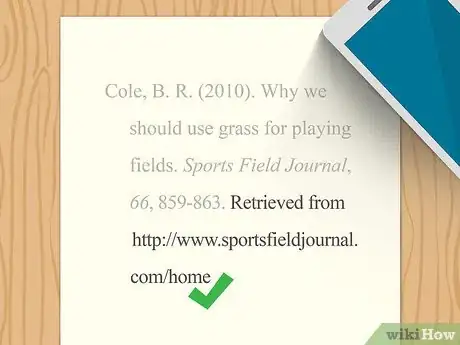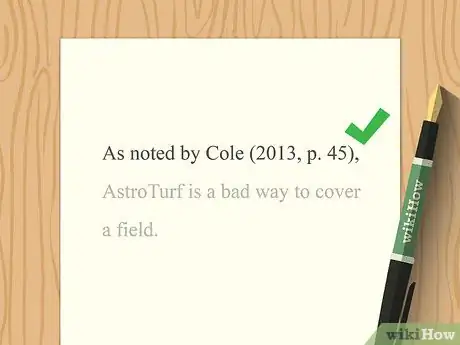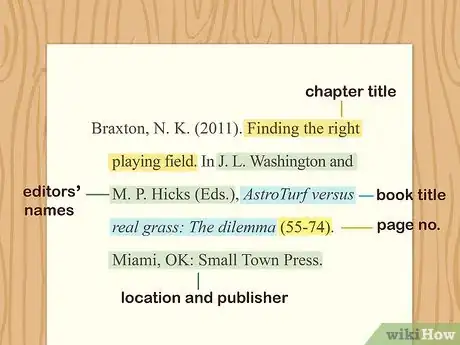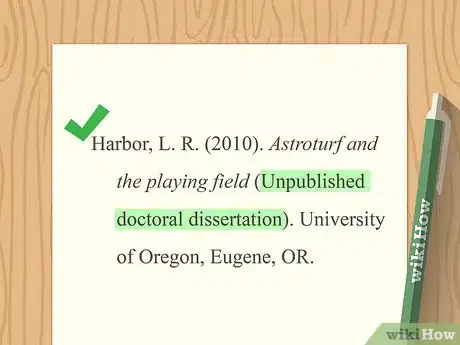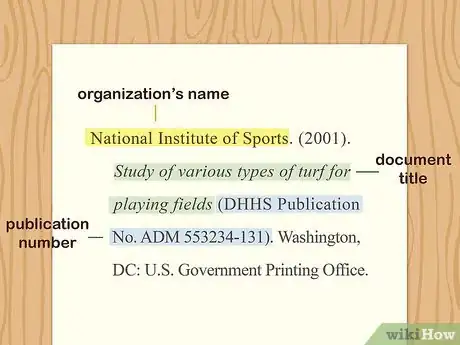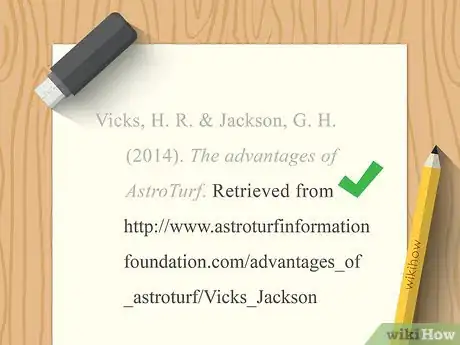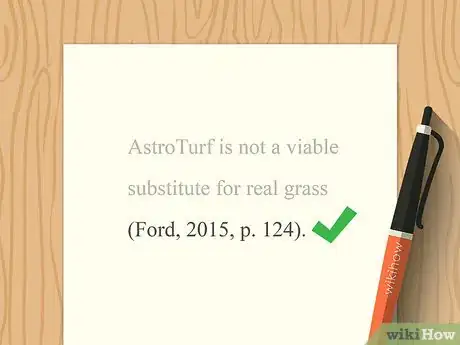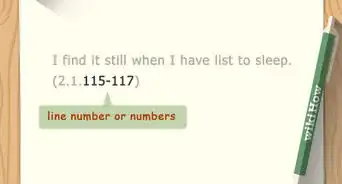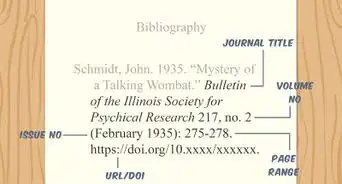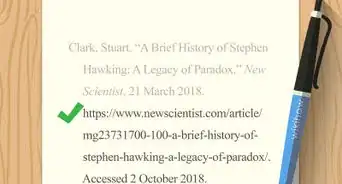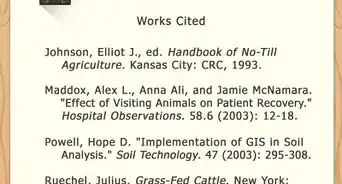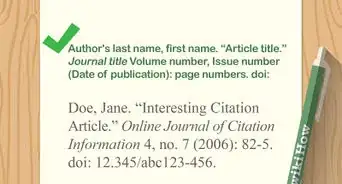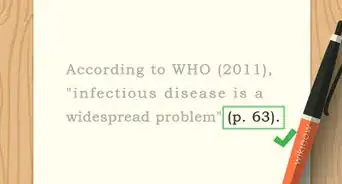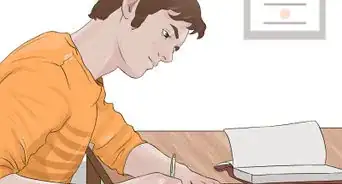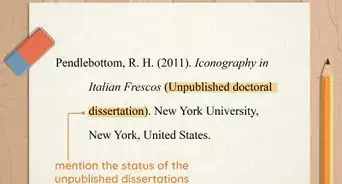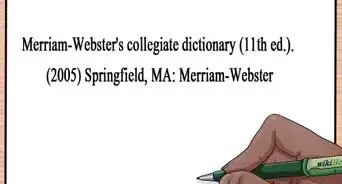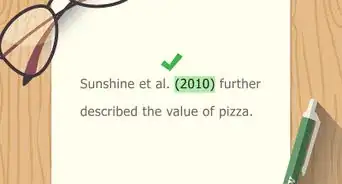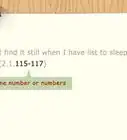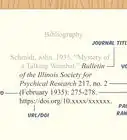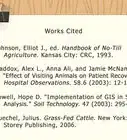This article was co-authored by wikiHow Staff. Our trained team of editors and researchers validate articles for accuracy and comprehensiveness. wikiHow's Content Management Team carefully monitors the work from our editorial staff to ensure that each article is backed by trusted research and meets our high quality standards.
There are 17 references cited in this article, which can be found at the bottom of the page.
This article has been viewed 114,418 times.
Learn more...
Many organizations use the APA (American Psychological Association) format for citing references, particularly the scientific disciplines. It emphasizes equality, which is why it favors initials instead of using first names, and recent research, which is why the date is included early in the citation. Start by formatting your in-text citations, then work on your reference list by creating entries for books, journal articles, and other sources.
Steps
Citing a Book
-
1Use the author's last name first to create a citation in the reference list. In APA style, you only use initials for the first and last name. Follow the last name with a comma, then add the person's first and middle initial, if both are included.[1]
- For instance, your citation would begin like this one:
- Ford, R. G.
- If the source has more than one author, separate them by commas and an ampersand.
- Ford, R. G., Macintosh, J. P., & Rose, P. M.
- For instance, your citation would begin like this one:
-
2Add the year of publication next. Place the year in parentheses, and follow it by a period. You can find the year of publication on the front or back of the title page.[2]
- Your entry will be like this:
- Ford, R. G. (2015).
Advertisement - Your entry will be like this:
-
3Put the title of the book next. Place the title in italics. Use sentence-style capitalization, which means you capitalize the first word only (and any proper nouns). That includes capitalizing the first word after a colon.[3]
- Your citation now is like this:
- Ford, R. G. (2015). The benefits of natural grass.
- Your citation now is like this:
-
4Place the location and publisher next. Add the city of publication, a comma, and the state's abbreviation. Then, put a colon, followed by the publisher. Use a period after the publisher.[4]
- Now, your entry will look this way:
- Ford, R. G. (2015). The benefits of natural grass. Eugene, Oregon: University of Oregon.
- This citation is complete if you have no other information.
- Now, your entry will look this way:
-
5Add the addition after the title if second edition or later. Put the edition in parentheses using numbers (2nd, 3rd, etc.) and the abbreviation "ed." Put it before the title's final period. You can find this information on the back of the title page.[5]
- The citation would be like this:
- Ford, R. G. (2015). The benefits of natural grass (3rd ed.). Eugene, Oregon: University of Oregon.
- The citation would be like this:
-
6Include the translator after the title if it has one. Place the translator in parentheses with the initials, then the last name. Add the abbreviation "Trans." after the person's name. It should go after the title's final period.[6]
- Your citation will look like this:
- Ford, R. G. (2015). The benefits of natural grass. (Frank Roberts, Trans.). Eugene, Oregon: University of Oregon.
- Your citation will look like this:
-
7Create the in-text citation. This citation goes in the sentence where you're citing the information. Use the author's last name, either in the sentence or in parentheses before the end punctuation. Then, add the year of publication, a comma, and a page number. While the page number isn't strictly necessary unless you're using a direct quote, it's still a good idea to include it.[7]
- Your citation will look like this:
- As noted by Ford (2015, p. 124), AstroTurf isn't a good alternative to grass.
- At the end of the sentence, it would look like this:
- AstroTurf is not a viable substitute for real grass (Ford, 2015, p. 124).
- If you need to add multiple authors, write it this way:
- As noted by Ford, Macintosh, & Rose (2015, p. 88), AstroTurf can be damaging to players.
- After the first citation with multiple authors, write it like this:
- As noted by Ford et al. (2015, p. 75), AstroTurf is detrimental.
- Your citation will look like this:
Making a Bibliographical Entry for a Journal Article
-
1Begin with the author's last name, followed by their initials for your reference list citation. Just like a book entry, use the author's last name at the beginning. Use a comma between the last name and first initial. Add a middle initial if the book includes it or a middle name.[8]
- The reference page entry will begin this way:
- Cole, B. R.
- If it has more than one author, include all of them, separated by commas and an ampersand, in the same order they are listed in the journal article. List the authors' last name followed by a comma, then their first and middle initials, like this:
- Cole, B. R., Jackson, G. H., & Briar, J. P.
- The reference page entry will begin this way:
-
2Add the year of publication next. Put the year in parentheses. Typically, you can find the year at the beginning of the article or on the database entry for the journal article. Use a period after the end parenthesis.[9]
- Your reference will look like this:
- Cole, B. R. (2010).
- Your reference will look like this:
-
3Use the journal article title next. Do not put it in italics, and use sentence-style capitalization. That means that you only capitalize the first word, proper nouns, and the first word after a colon.[10]
- Now the entry will look this way:
- Cole, B. R. (2010). Why we should use grass for playing fields.
- Now the entry will look this way:
-
4Add the name of the journal after the article title. Capitalize the journal title like the journal does it, and put the name in italics. Use a comma after the journal name.[11]
- The reference will look like this:
- Cole, B. R. (2010). Why we should use grass for playing fields. Sports Field Journal,
- The reference will look like this:
-
5Add the volume, issue, and/or page numbers. Some journals are paginated by volume. In that case, you add the volume number in italics, a comma, and the page numbers of the article. Some journals are paginated by issue. In that case, add the volume in italics, the issue in parentheses but not in italics, and then the page numbers.[12]
- So for a journal paginated by volume, it will look like this:
- Cole, B. R. (2010). Why we should use grass for playing fields. Sports Field Journal, 66, 859-863.
- For a journal paginated by issue, you'll do it this way:
- Cole, B. R. (2010). Why we should use grass for playing fields. Sports Field Journal, 16(6), 20-16.
- If that's all the information you have, the citation is complete.
- So for a journal paginated by volume, it will look like this:
-
6Add the DOI if your journal article has one. Most articles will have a DOI, which is the digital object identifier. It's sort of like an ISBN for journal articles. New journal articles will usually have one, but if yours doesn't, you can leave it off.[13]
- Now your citation looks like this:
- Cole, B. R. (2010). Why we should use grass for playing fields. Sports Field Journal, 66, 859-863. doi:10.1434234234
- Now your citation looks like this:
-
7Use a web link for online articles if they don't have a DOI. The URL will help your readers find the article. Add "Retrieved from" and the URL address at the end of the entry.[14]
- For an article that has its own publicly accessible URL, put that in:
- Cole, B. R. (2010). Why we should use grass for playing fields. Sports Field Journal, 66, 859-863. Retrieved from http://www.sportsfieldjournal.com/why_we_should_use_grass
- If it doesn't have a publicly accessible URL, use the home page of the journal:
- Cole, B. R. (2010). Why we should use grass for playing fields. Sports Field Journal, 66, 859-863. Retrieved from http://www.sportsfieldjournal.com/home
- For an article that has its own publicly accessible URL, put that in:
-
8Make an in-text citation for the sentence where you're citing information. If you use the author's last name in the sentence, you don't need to put it in the citation; just place the citation directly after the last name. Otherwise, place the author's last name, a comma, the year of publication, a comma, and the page number in parentheses at the end of the sentence. You must include the page number with direct quotes; otherwise, it's optional.[15]
- If the author's name is in the sentence, the citation will look this way:
- As noted by Cole (2013, p. 45), AstroTurf is a bad way to cover a field.
- At the end of the sentence, it takes this form:
- AstroTurf is not a viable substitute for real grass (Ford, 2015, p. 124).
- If you need to add multiple authors, use this form:
- As noted by Cole, Jackson, & Briar (2014, p. 58), AstroTurf is bad for scoring goals.
- After the first citation with multiple authors, add "et al." instead:
- As noted by Cole et al. (2014, p. 66), AstroTurf is a problem when playing football.
- If the author's name is in the sentence, the citation will look this way:
Creating Other Bibliographical Entries
-
1Treat essays in books similarly to journal articles in your reference list citation. While you won't include all the same information, an essay in a book is similar. Use the author's name, the date, and the essay title, then add the name of the book. You'll use "In" with the editors names before the title, followed by a comma and the title. Then you'll add the location and publisher.[16]
- So an essay entry would look like this:
- Braxton, N. K. (2011). Finding the right playing field. In J. L. Washington and M. P. Hicks (Eds.), AstroTurf versus real grass: The dilemma (55-74). Miami, OK: Small Town Press.
- You need the "Eds." in parentheses to tell the viewer that those are the editors. The numbers in the parentheses after the title (in italics) are the page numbers of the essay in the book.
- So an essay entry would look like this:
-
2Note whether a dissertation is unpublished if citing it. Treat it like a book, mostly, but add "Unpublished doctoral dissertation" after the title in parentheses if it's unpublished. Then put the name of the institution, a comma, and the location.[17]
- So a basic entry would look like this:
- Harbor, L. R. (2010). Astroturf and the playing field (Unpublished doctoral dissertation). University of Oregon, Eugene, OR.
- If it's published, use "Doctoral dissertation," a period, then "Retrieved from" and the database. You'll also need the accession or order number in parentheses, like this:
- Price, H. F. (2012). Why AstroTurf should be outlawed (Doctoral dissertation). Retrieved from Sports Central Database. (244412321)
- So a basic entry would look like this:
-
3Put the organization's name first if that's the author. Some pamphlets and informative documents are authored by organizations or corporations. Instead of an individual, use the organization's name in place of the author's name. If it has an individual author, put it at the end, after the location.[18]
- Your citation might look like this:
- The Society for the Best Playing Fields. (2009).Data on injuries across different types of fields. Eugene, OR: G. H. Roberts.
- Do the same for a government document, but add any publication numbers after the title in parentheses, and use the publisher at the end:
- National Institute of Sports. (2001). Study of various types of turf for playing fields (DHHS Publication No. ADM 553234-131). Washington, DC: U.S. Government Printing Office.
- Your citation might look like this:
-
4Add the URL at the end of the citation for a webpage. If you're using a report or document from online, put the author and date of publication first. Then, use the title of the document in italics. Finally, add "Retrieved from" and a URL for the webpage.[19]
- For instance, you might write:
- Vicks, H. R. & Jackson, G. H. (2014). The advantages of AstroTurf. Retrieved from http://www.astroturfinformationfoundation.com/advantages_of_astroturf/Vicks_Jackson
- For instance, you might write:
-
5Add the in-text citation to the sentence you're citing. When making an in-text citation, you can use the author's name in the sentence; in that case, the citation can go directly after the name in parentheses without the author's last name in it. Otherwise, the citation goes in parentheses at the end of the sentence. Include the author's last name, a comma, the publication date, a comma, and the page number. Use the page number with a direct quote; if you're not making a direct quote, it's nice to have, but not necessary.[20]
- If the author's name is in the sentence, use this form:
- As noted by Ford (2015, p. 124), AstroTurf isn't a good alternative to grass.
- At the end of the sentence, the citation will look this way:
- AstroTurf is not a viable substitute for real grass (Ford, 2015, p. 124).
- If you need to add multiple authors, list all of them:
- As noted by Ford, Macintosh, & Rose (2015, p. 88), AstroTurf can be damaging to players.
- After the first citation with multiple authors, put in "et al." instead:
- As noted by Ford et al. (2015, p. 75), AstroTurf is detrimental.
- If the author's name is in the sentence, use this form:
Expert Q&A
-
QuestionWhat are some general tips for creating a reference page or a bibliography?
 Diane StubbsDiane Stubbs is a Secondary English Teacher with over 22 years of experience teaching all high school grade levels and AP courses. She specializes in secondary education, classroom management, and educational technology. Diane earned a Bachelor of Arts in English from the University of Delaware and a Master of Education from Wesley College.
Diane StubbsDiane Stubbs is a Secondary English Teacher with over 22 years of experience teaching all high school grade levels and AP courses. She specializes in secondary education, classroom management, and educational technology. Diane earned a Bachelor of Arts in English from the University of Delaware and a Master of Education from Wesley College.
Secondary English Teacher It really comes down to reading a rule, looking at an example, and then applying it to your own information. You have to pay attention to everything, such as, whether or not punctuation is included, whether or not there is an extra space, or whether or not something should be capitalized or italicized. Most times in bibliographies, the rules do not follow the standard conventions of English, so you cannot rely on your knowledge of the capitalization rules. You can find tools that will help you create the reference page, but in the long run, you are your best source.
It really comes down to reading a rule, looking at an example, and then applying it to your own information. You have to pay attention to everything, such as, whether or not punctuation is included, whether or not there is an extra space, or whether or not something should be capitalized or italicized. Most times in bibliographies, the rules do not follow the standard conventions of English, so you cannot rely on your knowledge of the capitalization rules. You can find tools that will help you create the reference page, but in the long run, you are your best source. -
QuestionWhen using in-text citations, do I have to put what the author says in quotation marks?
 Community AnswerYes. The text must be enclosed by quotation marks, unless you are paraphrasing what they've said.
Community AnswerYes. The text must be enclosed by quotation marks, unless you are paraphrasing what they've said.
References
- ↑ https://owl.purdue.edu/owl/research_and_citation/apa_style/apa_formatting_and_style_guide/reference_list_books.html
- ↑ https://owl.purdue.edu/owl/research_and_citation/apa_style/apa_formatting_and_style_guide/reference_list_author_authors.html
- ↑ https://owl.purdue.edu/owl/research_and_citation/apa_style/apa_formatting_and_style_guide/reference_list_books.html
- ↑ https://owl.purdue.edu/owl/research_and_citation/apa_style/apa_formatting_and_style_guide/reference_list_books.html
- ↑ https://owl.purdue.edu/owl/research_and_citation/apa_style/apa_formatting_and_style_guide/reference_list_books.html
- ↑ https://owl.purdue.edu/owl/research_and_citation/apa_style/apa_formatting_and_style_guide/reference_list_books.html
- ↑ https://owl.purdue.edu/owl/research_and_citation/apa_style/apa_formatting_and_style_guide/in_text_citations_the_basics.html
- ↑ https://apastyle.apa.org/style-grammar-guidelines/references/examples/journal-article-references
- ↑ https://libraryguides.vu.edu.au/apa-referencing/7JournalArticles
- ↑ https://libraryguides.vu.edu.au/apa-referencing/7JournalArticles
- ↑ https://libraryguides.vu.edu.au/apa-referencing/7JournalArticles
- ↑ https://owl.purdue.edu/owl/research_and_citation/apa_style/apa_formatting_and_style_guide/reference_list_articles_in_periodicals.html
- ↑ https://libraryguides.vu.edu.au/apa-referencing/7JournalArticles
- ↑ https://owl.purdue.edu/owl/research_and_citation/apa_style/apa_formatting_and_style_guide/reference_list_electronic_sources.html
- ↑ https://owl.purdue.edu/owl/research_and_citation/apa_style/apa_formatting_and_style_guide/in_text_citations_the_basics.html
- ↑ https://libguides.unf.edu/citationguide/apasample
- ↑ https://apastyle.apa.org/style-grammar-guidelines/references/examples/unpublished-dissertation-references
- ↑ https://owl.purdue.edu/owl/research_and_citation/apa_style/apa_formatting_and_style_guide/reference_list_other_print_sources.html
- ↑ https://owl.purdue.edu/owl/research_and_citation/apa_style/apa_formatting_and_style_guide/reference_list_electronic_sources.html
- ↑ https://owl.purdue.edu/owl/research_and_citation/apa_style/apa_formatting_and_style_guide/in_text_citations_the_basics.html
- ↑ https://ucsd.libguides.com/c.php?g=91010&p=584738
About This Article
The right way to cite a source using APA depends on what you're sourcing. To write an in-text citation for a book in APA, start with the author’s last name, then the year the material was published, and finally the page number. Place this information in parentheses at the end of the sentence with the quoted or paraphrased material. To cite a book in your reference list at the end of your essay, start with the author’s last name, then their initials. Follow this with the year of publication and the title of the book. If this is a second edition or later, or if there was a translator, note this information after the title. Finally, add the city of publication, the state’s abbreviation, and the publisher. To learn how to punctuate your reference citations, keep reading!
